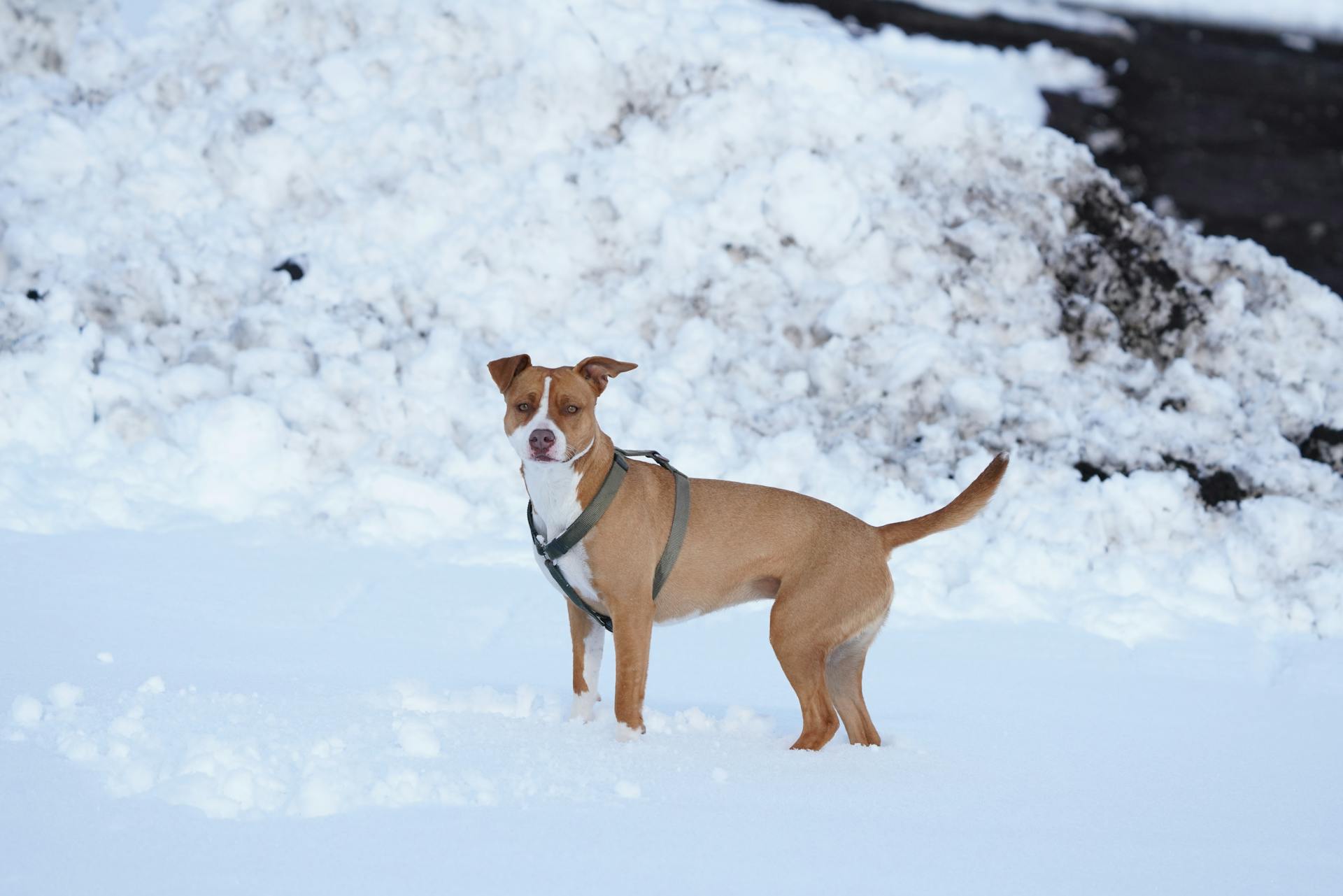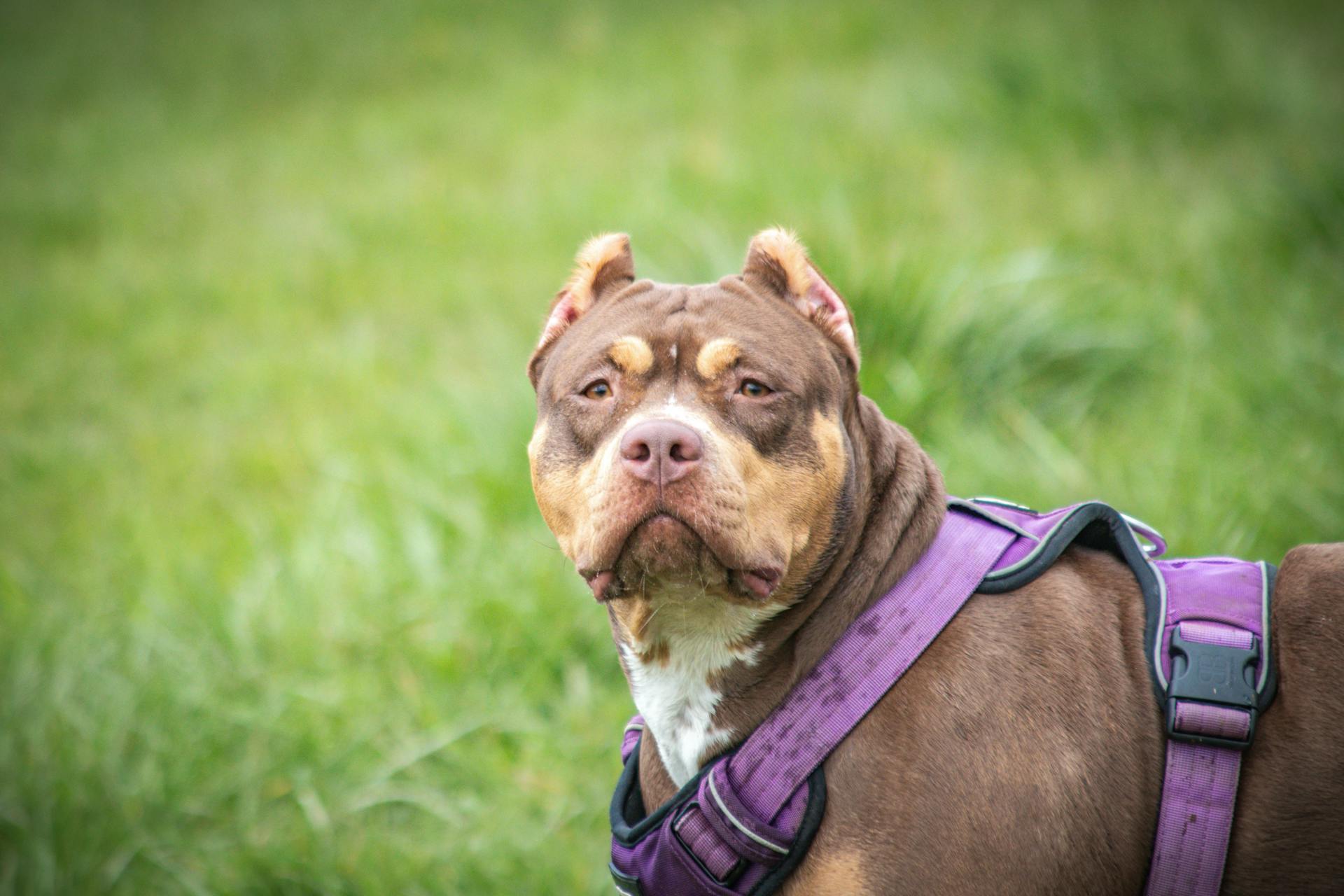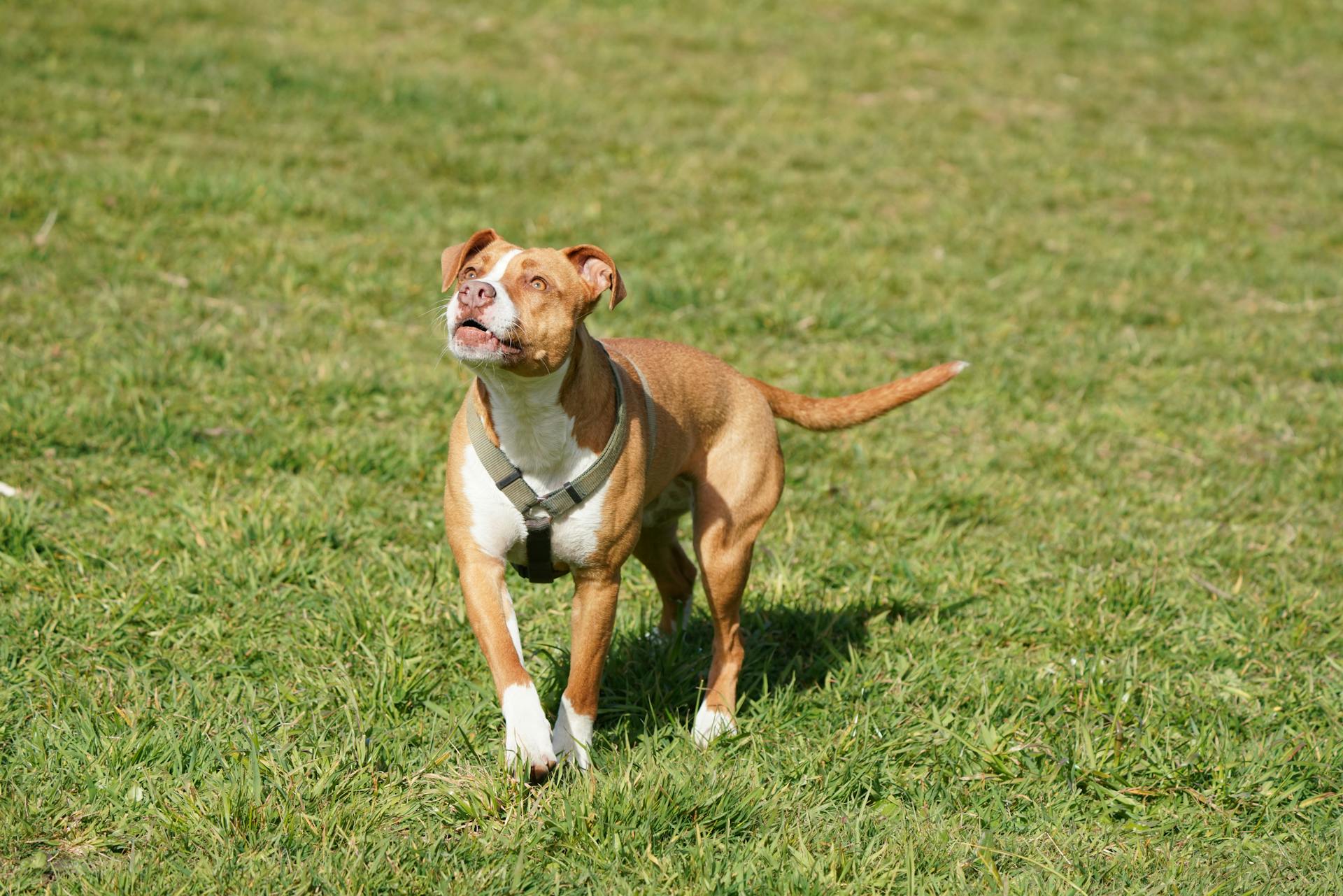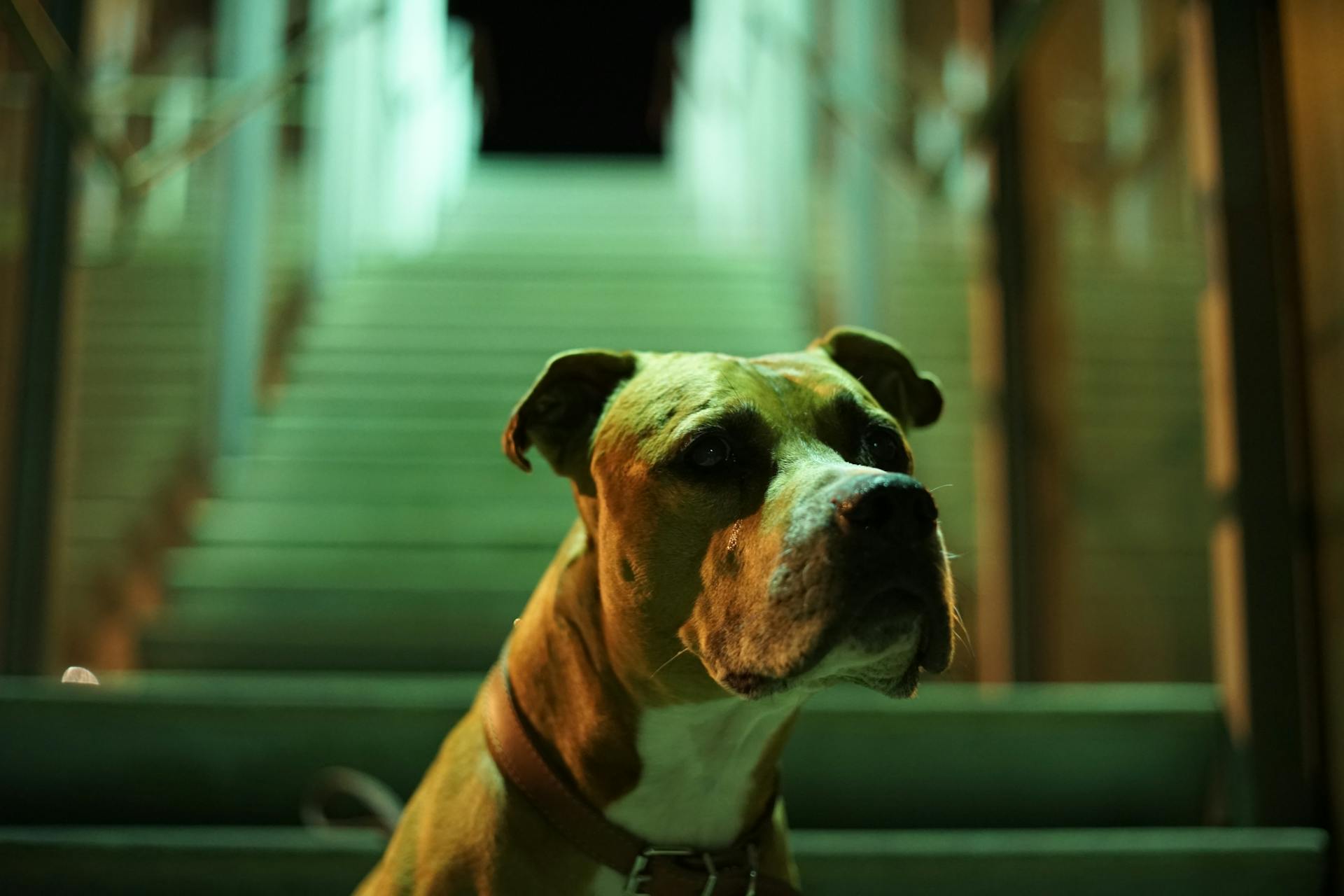
The term "full-blooded" when referring to Pit Bulls, specifically means that the dog is a direct descendant of the original Pit Bull breeds, with no other breeds mixed in. This is important because it affects their physical characteristics and temperament.
A full-blooded Pit Bull typically has a muscular build, a broad chest, and a short, smooth coat that comes in a variety of colors. They can weigh between 35 and 60 pounds and stand between 17 and 20 inches tall at the shoulder.
One of the most distinctive features of full-blooded Pit Bulls is their head shape, which is broad and flat, with a well-defined stop and a black nose. Their eyes are usually brown or hazel, and their ears are erect and triangular in shape.
Full-blooded Pit Bulls are known for their loyalty and affection towards their families, but they can be wary of strangers and may require time to warm up to new people.
A different take: Pure Shih Tzu Puppy
Breed Classification
The term "pit bull" can be broken down into three components: pit, bull, and terrier. Pit acknowledges the dog's history as a fighting dog, while bull highlights the dog's bulldog ancestry and terrier describes the dog's terrier ancestry.
The American Kennel Club (AKC) registers American Staffordshire Terriers and Staffordshire Bull Terriers, while the United Kennel Club (UKC) registers American Pit Bull Terriers and Staffordshire Bull Terriers. Their breed standards can be accessed at the following links.
Here's a list of the breeds that are technically considered pit bulls:
- American Pit Bull Terrier
- American Staffordshire Terrier
- Staffordshire Bull Terrier
These breeds are characterized by their proportional and fairly streamlined body shape, with no part of the body looking "oversized."
Castillo
The Castillo bloodline is a lineage of American Pit Bull Terriers known for its unique combination of different breeding lines. This combination results in dogs with desirable traits such as strength, intelligence, and temperament.
Tekla Castillo founded the program in the early 1980s, focusing on conformation standards within the UKC. The bloodline's foundation includes dogs such as "PR" Nelson's Hazard Joe.
The Castillo bloodline features a mix of other well-known bloodlines, with connections to influential dog breeders like Earl Tudor, Joe Corvino, J.P. Colby, and others. This interconnected nature of the breeding community has expanded the Castillo lineage over time.
Explore further: Purebred English Bull Terrier
Technical Definition
The term "pit bull" can be broken down into three components: pit, bull, and terrier. This breakdown gives us a clue about the breed's history and ancestry.
In the context of dog fighting, the term "pit" acknowledges the breed's history as a fighting dog. The breed's bulldog ancestry is highlighted by the word "bull", while "terrier" describes its terrier ancestry.
The term "pit bull" specifically refers to a dog whose ancestors were Bull-and-Terrier type dogs once used for dog fighting. This technical definition includes the American Pit Bull Terrier, American Staffordshire Terrier, and Staffordshire Bull Terrier breeds.
To clarify, not all fighting dogs are pit bulls, and not all pit bulls were used for fighting. The three elements of the breed's ancestry (Bulldog, Terrier, and fighting dog) come together only in the pit bull type dog.
Here's a breakdown of the breeds included in the technical definition of "pit bull":
- American Pit Bull Terrier
- American Staffordshire Terrier
- Staffordshire Bull Terrier
These breeds share a common ancestry and were once used for dog fighting. It's worth noting that other breeds, such as Akitas and Bull Terriers, have similar characteristics but are not included in the technical definition of "pit bull."
American Staffordshire Terrier
The American Staffordshire Terrier is a breed that has a long and complex history. It was originally referred to as the American Bull Terrier, but the name was later changed to avoid confusion with the English Bull Terrier.
In 1936, the AKC stud book was opened to register the breed, with around 50 UKC dogs entering under the name Staffordshire Terrier. The breed was later renamed to American Staffordshire Terrier in 1972.
The American Staffordshire Terrier is often confused with the American Pit Bull Terrier, but they are considered separate breeds by many kennel clubs. The AKC does not accept American Pit Bull Terriers as American Staffordshire Terriers, and the ADBA considers most dual-registered dogs as American Staffordshire Terriers.
The breed standard for the American Staffordshire Terrier is slightly different from that of the American Pit Bull Terrier. AKC champion dogs are generally heavier and more robust than UKC and ADBA champion dogs.
See what others are reading: Pit Bulls Real Name
Here are some key differences between the American Staffordshire Terrier and the American Pit Bull Terrier:
- Weight: American Staffordshire Terriers should weigh between 28 and 48 lbs, while American Pit Bull Terriers should weigh no more than 65 lbs.
- Body shape: American Staffordshire Terriers should have a more compact body shape, while American Pit Bull Terriers should have a more streamlined body shape.
- Red nose: The AKC standard does not accept red nose dogs, while the UKC and ADBA do.
The American Staffordshire Terrier is a beloved breed that has been a part of American history for over a century.
Similar-Looking Breeds
If you're interested in learning more about pit bulls, you're probably aware that there are several breeds that resemble them. The American Pit Bull Terrier, American Staffordshire Terrier, and Staffordshire Bull Terrier are often confused with one another.
The American Pit Bull Terrier and American Staffordshire Terrier have very similar appearances, to the point that some APBTs are actually dual-registered as ASTs. They should weigh no more than 65 lbs at a healthy weight.
The Staffordshire Bull Terrier, on the other hand, is a smaller dog that should weigh between 28 and 48 lbs. In all cases, the dog's overall body shape should be proportional and fairly streamlined.
Here's a quick rundown of the weights for these breeds:
It's worth noting that the Bull Terrier, while similar in name, is not a pit bull breed and is actually a bulldog-and-terrier cross.
Temperament and Health
The American Pit Bull Terrier is known for its confident and enthusiastic personality, making it a great breed for active families. This breed is eager to please and has a high level of intelligence, which makes it excel in performance events.
The breed's natural agility also makes it a skilled climber, so good fencing is a must to keep it safe. However, media portrayal has significantly impacted how the public views the temperament of APBT, with many people falsely reporting stocky short-haired dogs as Pit Bulls.
A study from 2002 suggests that news media exaggerates and exacerbates any real or potential problems that exist with Pit Bulls. This has led to a lower probability of adoption or even being taken into shelters for care.
The breed tends to be hardy, with an average lifespan of 12 to 14 years, longer than many breeds of a similar size. However, there are some genetic conditions to be watchful for, such as hip dysplasia and kneecap dislocation.
Colby

The Colby dogs are an ancient black-nosed bloodline that served as one of the pillars of the APBT breed. They were started by John Pritchard Colby in 1889, who acquired the best fighting dogs imported from Ireland and England.
Colby's Pincher was a famous dog of his bloodline, widely used as a stud dog, and is present in the pedigree of the vast majority of APBT specimens.
Hindquarters
The hindquarters are a crucial part of a dog's overall structure and can give us clues about their temperament and health. A well-developed hindquarters is strong, muscular, and moderately broad.
The rump is well filled in on each side of the tail and deep from the pelvis to the crotch. This indicates a sturdy build that can support the dog's weight and movement.
Narrow hindquarters, on the other hand, can be a sign of underlying health issues or genetic problems. This fault can also affect the dog's mobility and overall quality of life.
See what others are reading: Pembroke Welsh Corgi Health

A dog with well-developed thighs and thick, easily discerned muscles is likely to be a happy and energetic companion. This muscle mass is essential for their overall health and well-being.
Straight or over angulated stifle joints can cause pain and discomfort for the dog, leading to behavioral issues and reduced quality of life. This fault can also be a sign of underlying health problems that need to be addressed.
Cow hocks, sickle hocks, and bowed legs are all potential faults that can affect a dog's hindquarters. These conditions can cause pain and discomfort, and may require veterinary attention to correct.
Consider reading: Bernese Mountain Dog Issues
Temperament
The American Pit Bull Terrier is a breed known for its strength, confidence, and zest for life. This breed is eager to please and brimming over with enthusiasm.
The breed's natural agility makes it one of the most capable canine climbers, so good fencing is a must for this breed. This breed does very well in performance events because of its high level of intelligence and its willingness to work.
The American Pit Bull Terrier was historically bred for dog-aggression, not human-aggression. Before a fight, dog handlers would wash each other's dogs, and in the heat of a dog fight, handlers had to be very close to their dogs.
The breed standards describe the proper temperament of the American Pit Bull Terrier as one of confidence, determination, courage, and tolerance. The breed standards also emphasize that the dog should never be unmanageable.
Pit bulls have a lower probability of adoption or even being taken into shelters for care due to media portrayal and false reporting. Many people, including experts, falsely report any stocky short-haired dogs as Pit Bulls.
Health
American Pit Bull Terriers are generally a hardy breed with an average lifespan of 12 to 14 years.
Due to their athleticism and diverse breeding background, they tend to be less prone to certain health issues. However, they can be susceptible to bone diseases such as hip dysplasia and kneecap dislocation.

They also have a higher than average incidence of hip dysplasia, but culling for performance has helped eliminate this problem.
Their short coat makes them more prone to skin problems like mange and skin allergies.
Culling for performance has also helped reduce the incidence of patella problems, thyroid dysfunction, and congenital heart defects.
As with any breed, vaccination is crucial to protect against parvovirus, especially as puppies.
They are prone to demodex mange, which can be caused by immunodeficiency genes passed on from their parents.
A simple skin scraping test can diagnose demodex mange, and ivermectin injections or oral medications are commonly used to treat it.
Activities and Sports
American Pit Bull Terriers are naturally talented in dog sports, with many excelling in weight pulling, dog agility, flyball, lure coursing, and advanced obedience competition. In fact, out of 115 dogs that have earned UKC "superdog" status, 34 have been American Pit Bull Terriers.
They're also highly versatile and can thrive in various working disciplines due to their intelligence, high energy, and endurance. This makes them suitable for tasks such as search and rescue, narcotics and explosives detection, and even catching feral pigs.
However, it's essential to note that hunting feral pigs can be hazardous for the dogs, with potential risks including severe injuries, heat exhaustion, poisoning, vehicular trauma, snake bites, and accidental shooting.
A different take: Staffordshire Bull Terrier for Adoption
Gait

The American Pit Bull Terrier's gait is truly impressive, conveying a sense of confidence and energy. This breed moves with a smooth, powerful, and well-coordinated stride, showing good reach in front and drive behind.
As you watch an American Pit Bull Terrier trot, you'll notice that its topline remains level, with only a slight flexing to indicate suppleness. This flexibility is essential for a breed that's built for agility and speed.
Legs that move on the same plane are a hallmark of a good gait in the American Pit Bull Terrier. This means that each leg should be parallel to the one next to it, creating a smooth and efficient stride.
Faults in gait can be a problem, and some common issues include legs crossing over in front or rear, or rear legs moving too close or touching. These faults can affect the dog's balance and overall movement.
Recommended read: Smooth Fox Terrier Breeders
Getting Started in Dog Sports
Getting Started in Dog Sports is an exciting journey that can bring you and your dog closer together. The American Pit Bull Terrier, for example, excels in many dog sports, including weight pulling, dog agility, flyball, lure coursing, and advanced obedience competition.
If you're new to dog sports, start by learning about the basics. Intro to Dog Sports is a great place to begin, covering the fundamentals of dog sports and what to expect.
The American Pit Bull Terrier is a working dog and is suitable for a wide range of working disciplines due to their intelligence, high energy, and endurance. This breed has been used as search and rescue dogs, police dogs, and even Border Patrol dogs.
To get started in dog training, consider enrolling in a program that suits your dog's breed and needs. Canine Partners is a great resource for mixed-breed dogs, and many organizations offer training programs specifically designed for certain breeds.
Additional reading: Working Bull Terrier
The UKC "superdog" status, earned by only 115 dogs worldwide, is a testament to the American Pit Bull Terrier's potential in dog sports. Out of these dogs, 34 have been American Pit Bull Terriers, and another 13 were American Staffordshire Terriers.
If you're unsure which dog sport is right for you and your dog, consider the following options: Canine Partners / Enroll Mixed Breed, Titles & Abbreviations, Which Sport Should You Do With Your Dog?, Get Started in Dog Training, and Virtual Dog Sports & Events.
Frequently Asked Questions
Is there a full-blooded pitbull?
No, there is no such thing as a purebred pit bull, as the term is a catch-all for dogs of various mixed breeds. Learn more about the history and characteristics of pit bull-type dogs.
What is a pure pitbull called?
There is no single "pure" Pitbull breed; instead, the term "Pitbull" refers to a group of three registered breeds: Staffordshire Bull Terrier, American Staffordshire Terrier, and American Pit Bull Terrier.
What are the four types of pitbulls?
The four main types of pitbulls are the American Pitbull Terrier, American Staffordshire Terrier, Staffordshire Bull Terrier, and American Bully, each with unique characteristics and origins. Discover the fascinating differences between these breeds and learn more about their history, temperament, and needs.
How much does a full blooded pitbull weigh?
A full-grown American Pit Bull Terrier typically weighs between 35-60 pounds (males) or 30-50 pounds (females). Males tend to weigh more than females, but individual weights can vary.
Sources
- https://en.wikipedia.org/wiki/American_Pit_Bull_Terrier
- https://www.ukcdogs.com/american-pit-bull-terrier
- https://animalfoundation.com/whats-going-on/blog/pitbull-breed
- https://www.akc.org/dog-breeds/american-staffordshire-terrier/
- https://www.shawpitbullrescue.com/can-you-find-the-pit-bull/what-is-a-pit-bull/
Featured Images: pexels.com


